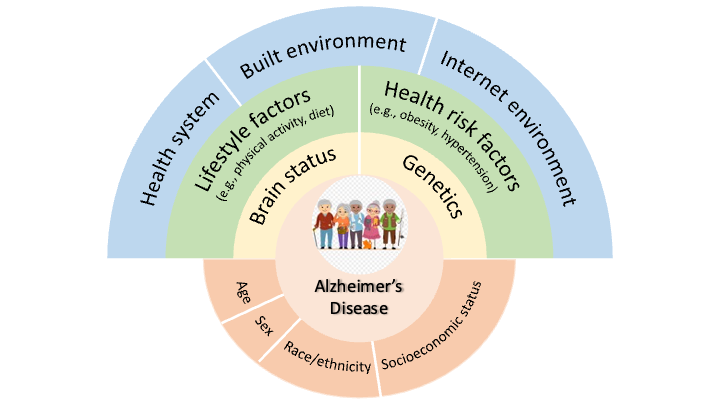Teaming for Interdisciplinary Research Pre-Seed Program
Interdisciplinary Approaches to Alzheimer’s Disease Prevention

In 2020, Alzheimer’s disease (AD) was the seventh leading cause of death in the US (134,242 deaths). About 6.2 million US adults aged 65 or older were living with AD in 2021, and the number could increase to 13.8 million in 2060. The total health- and long-term care costs for AD patients were approximately $355 billion in 2021. However, there are limited treatments to slow AD progression, and no cure approaches. Thus, identifying modifiable risk factors associated with incidence, mortality, and disparities in AD may assist in preventing and delaying cognitive decline as well as the onset of AD.
Current evidence shows that AD could be associated with three-level risk factors, including society level, individual level, and biological level. Examining the multiple risk factors across the three different levels may shed light on the comprehensive interrelationships among them and reveal their synergistic contribution to AD prevention. We hypothesize that modifying the combination of risk factors across levels could be more effective at reducing the risks of AD than focusing on individual factors alone. However, to date, much of the current research mainly focuses on individual risk factors.
We propose to explore risk factors across levels using a multi-disciplinary team of investigators, including health policy, epidemiology, gerontology, neuroscience, geography, genetics, and computer science. Our interdisciplinary team, composed of 12 faculty members in six different departments, is well-equipped to examine the association between each type of risk factor and AD among different population groups by age, sex, race/ethnicity, and socioeconomic status (SES). Outcomes include cognitive function, mild cognitive impairment, dementia, and/or deaths due to AD. We combine expertise in assessing the synthetical contributions of the following seven risk factors to AD prevention:
- Health system (Chen, Khan, Song; analyzing health resource distribution, utilization, and access to health care services);
- Built environment (Mai, Song, Sun, Yao; using computer vision methods and geographical analysis to identify the built environmental features);
- Internet environment (Liu, Mai, Song, Yao; using machine learning and causal inference methods to explore the social media activities and contents related to AD);
- Lifestyle factors (Emerson, Renzi-Hammond, Shen, Song, Ye; examining healthy behaviors, such as physical activity, diet, and sleep);
- Health risk factors (Rajbhandari-Thapa, Shen, Song; investigating cardiovascular risk factors, such as hypertension and obesity);
- Brain status (Liu, Renzi-Hammond, Song; examining whether the modifiable risk factors could attenuate the association between brain and AD);
- Genetics (Song, Ye; investigating the relationship between polygenic risk score and AD, and how modifiable risk factors could influence such relationship).
The specific aims of this study are (1) to describe the prevalence and mortality of AD among different population groups, including persons in rural and medically underserved communities, (2) to examine the association of modifiable risk factors (factors 1-5) with cognition and/or AD, and assess the contribution of each factor to the prevention of cognition/AD, (3) to investigate the association between non-modifiable risk factors (factors 6 & 7) and cognition/AD, (4) to explore whether the modifiable risk factors could mitigate the association between non-modifiable risk factors and cognition/AD.
The goals of this interdisciplinary team are to host regular seminars and meetings to discuss detailed strategies for this study, to invite potential external collaborators to present in the seminars or workshops, to organize sub-teams towards grant proposals, and to involve students in the collaborations, including co-authored publications.
We anticipate that this work will lead to several publishable papers and projects. The team activities will be the basis of proposals for external funding from sources such as National Institute on Aging (NIA), Agency for Healthcare Research and Quality (AHRQ), and private foundations.
Team Lead
Suhang Song
ss90706@uga.edu
College: Public Health
Department: Health Policy and Management
Team Members
Zhuo Chen
zchen1@uga.edu
College: Public Health
Department: Health Policy and Management
Kerstin Emerson
emerson@uga.edu
College: Public Health
Department: Health Policy and Management / Institute of Gerontology
Mahmud Khan
Mahmud.Khan@uga.edu
College: Public Health
Department: Health Policy and Management
Tianming Liu
tliu@cs.uga.edu
College: Franklin
Department: Computer Science
Gengchen Mai
gengchen.mai25@uga.edu
College: Franklin
Department: Geography
Janani Rajbhandari-Thapa
jrthapa@uga.edu
College: Public Health
Department: Health Policy and Management
Lisa Renzi-Hammond
lrenzi@uga.edu
College: Public Health
Department: Health Promotion and Behavior / Institute of Gerontology / Division of Neuroscience
Ye Shen
yeshen@uga.edu
College: Public Health
Department: Epidemiology and Biostatistics / Institute of Gerontology
Jin Sun
jinsun@uga.edu
College: Franklin
Department: Computer Science
Xiaobai Yao
xyao@uga.edu
College: Franklin
Department: Geography
Kaixiong Ye
kaixiong.ye@uga.edu
College: Franklin
Department: Genetics
